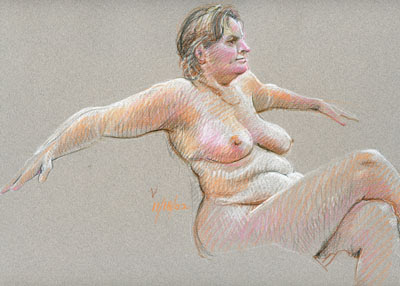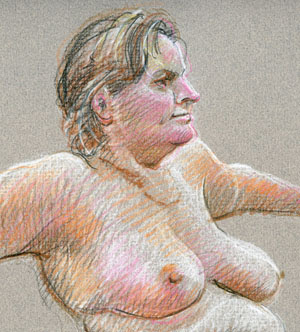
Here is a Prismacolor pencil drawing of a few years ago that might be instructive to examine. In line with my earlier comments about the artist's hand, I mean an examination of this technique and how easily it can go wrong.
In last week's post we looked at the simplicity of ordinary pencil as a poetic treatment of subject matter. Here in an attempt to show realistic color we have a straight forward impression of this lady's form, color and character but too much a failure as art. You can see in the enlargement the relatively loose hatching used here, much less precise than that of last week's figures. I don't remember exactly what happened but it seems to me that I'd worked slowly and carefully building up the flesh tones with layered hatching but then, rushing at the end of the session to add those more emphatic darks. While there was certainly a need for some of those darks, the casual way they were done is a distinct distraction. You can see that most easily in the over-emphasis at the ribs and waist, and in those lumpy lines under her left breast and under her thigh. It hurts! Normally I'd never show anyone this piece but I make an exception here as a teaching tool. Sorry, there's not much poetry in this image!

If that had been my intention I shouldn't have paid so much attention to detail and actual likeness. I think now a generalized depiction would have been more successful; why I noted that mole on her cheek, I can't imagine! Thinking back, I remember a frequent admonition by one of my first drawing instructors, - "Don't be a wrinkle artist!" He wanted us to pay attention to structure rather than particular detail, to study human anatomy to understand what we saw and then reveal that structure by recording the play of light on the figure. I'm still working on all that!
Yes, I often say be the artist you want to be now! Think of yourself as an artist and do it now! Yes, do it but know that as a serious artist you'll be self-critical, always working to improve. I find that saving your work and from time to time bringing it out for re-evaluation does two things. You'll more easily see problems after that lapse of time and secondly, you be able to see your improvement over time.
BTW, You are not seeing the whole drawing even in the one atop the page with legs running off the page because of my scanner's size. The technique of "stitching" separate scans together, while useful, is much too time consuming for our purposes here.
"Be kind, for everyone you meet is fighting a hard battle." Plato
"Be kind, for everyone you meet is fighting a hard battle." Plato






